Taxation Theory, Practice, and Law: Comprehensive Report and Analysis
VerifiedAdded on 2020/06/04
|9
|2252
|38
Report
AI Summary
This report provides a detailed analysis of taxation theory, practice, and law through the examination of several case studies. The report begins by exploring capital gains tax, analyzing how it applies to the sale of assets held for varying periods, and the tax implications for individuals. It then delves into the intricacies of fringe benefits tax, explaining how these benefits are calculated and taxed, including loan benefits and interest rates. The report also examines tax avoidance strategies, such as those involving contracts and the allocation of income, highlighting the legal and practical aspects. Furthermore, it explores the taxation of revenue generated from forest operations, differentiating between those who actively engage in these operations and those who receive income from timber sales. The report utilizes case studies, supporting evidence, and critical analysis to offer a comprehensive understanding of the subject matter, referencing relevant tax laws and policies. The report concludes by summarizing key findings and implications of the various taxation scenarios discussed.
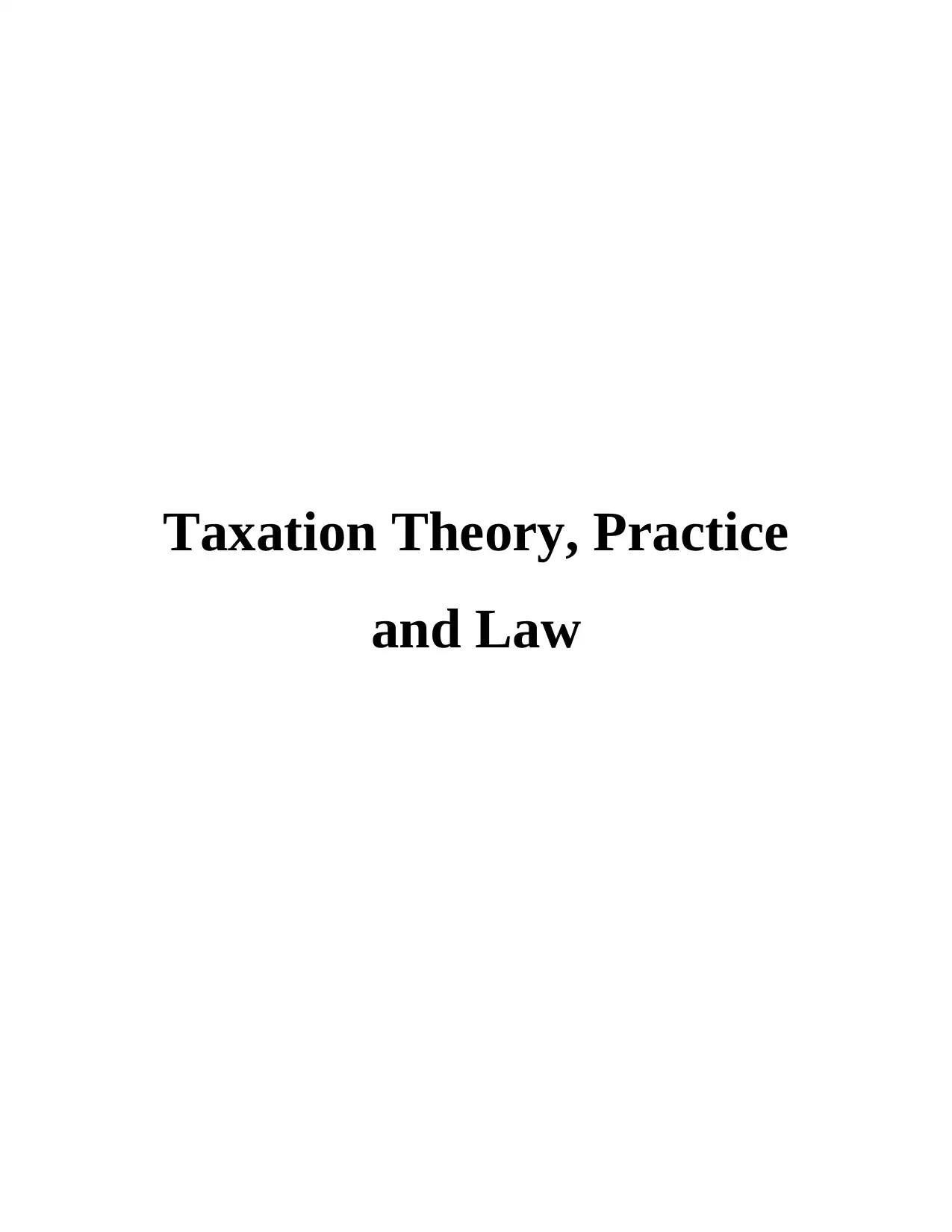
Taxation Theory, Practice
and Law
and Law
Paraphrase This Document
Need a fresh take? Get an instant paraphrase of this document with our AI Paraphraser
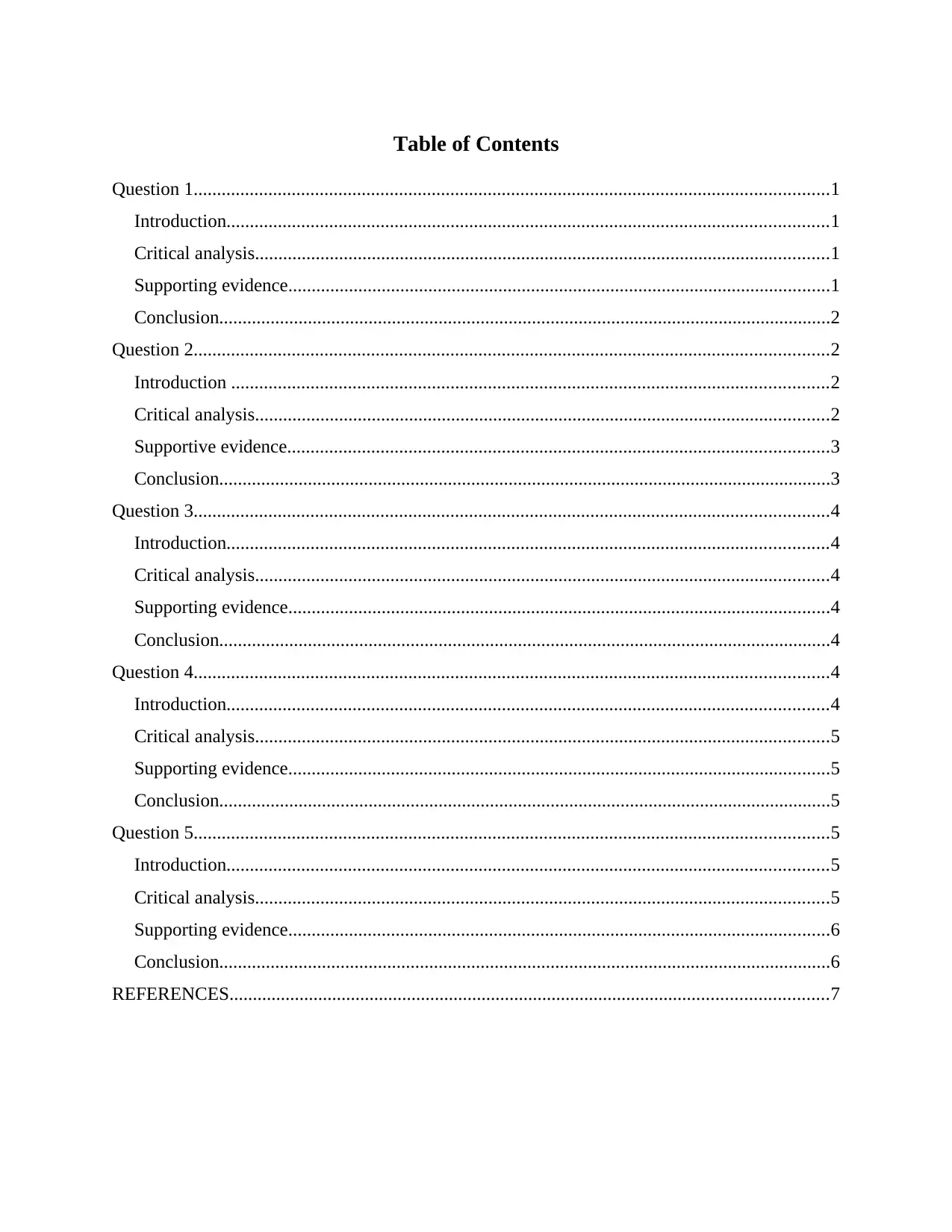
Table of Contents
Question 1........................................................................................................................................1
Introduction.................................................................................................................................1
Critical analysis...........................................................................................................................1
Supporting evidence....................................................................................................................1
Conclusion...................................................................................................................................2
Question 2........................................................................................................................................2
Introduction ................................................................................................................................2
Critical analysis...........................................................................................................................2
Supportive evidence....................................................................................................................3
Conclusion...................................................................................................................................3
Question 3........................................................................................................................................4
Introduction.................................................................................................................................4
Critical analysis...........................................................................................................................4
Supporting evidence....................................................................................................................4
Conclusion...................................................................................................................................4
Question 4........................................................................................................................................4
Introduction.................................................................................................................................4
Critical analysis...........................................................................................................................5
Supporting evidence....................................................................................................................5
Conclusion...................................................................................................................................5
Question 5........................................................................................................................................5
Introduction.................................................................................................................................5
Critical analysis...........................................................................................................................5
Supporting evidence....................................................................................................................6
Conclusion...................................................................................................................................6
REFERENCES................................................................................................................................7
Question 1........................................................................................................................................1
Introduction.................................................................................................................................1
Critical analysis...........................................................................................................................1
Supporting evidence....................................................................................................................1
Conclusion...................................................................................................................................2
Question 2........................................................................................................................................2
Introduction ................................................................................................................................2
Critical analysis...........................................................................................................................2
Supportive evidence....................................................................................................................3
Conclusion...................................................................................................................................3
Question 3........................................................................................................................................4
Introduction.................................................................................................................................4
Critical analysis...........................................................................................................................4
Supporting evidence....................................................................................................................4
Conclusion...................................................................................................................................4
Question 4........................................................................................................................................4
Introduction.................................................................................................................................4
Critical analysis...........................................................................................................................5
Supporting evidence....................................................................................................................5
Conclusion...................................................................................................................................5
Question 5........................................................................................................................................5
Introduction.................................................................................................................................5
Critical analysis...........................................................................................................................5
Supporting evidence....................................................................................................................6
Conclusion...................................................................................................................................6
REFERENCES................................................................................................................................7
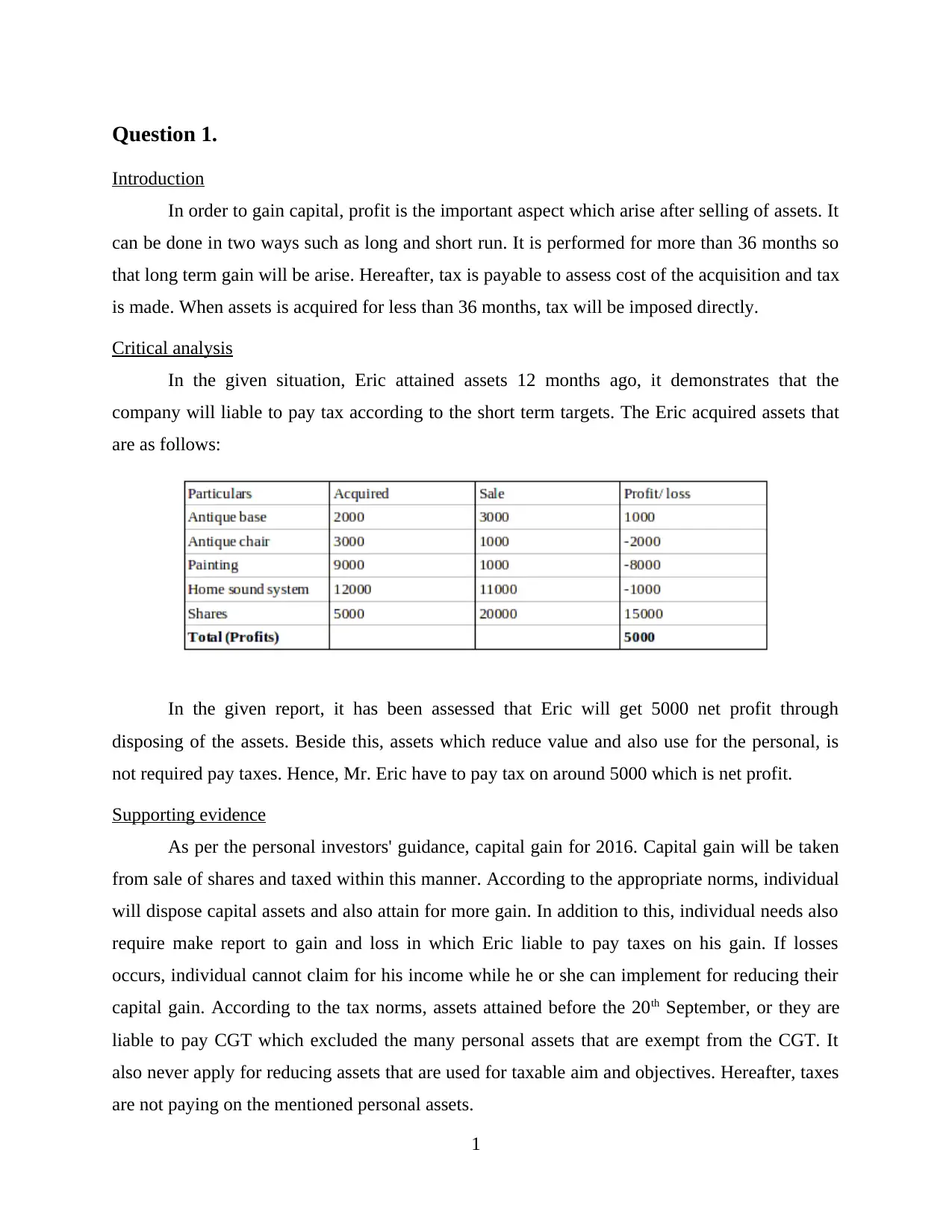
Question 1.
Introduction
In order to gain capital, profit is the important aspect which arise after selling of assets. It
can be done in two ways such as long and short run. It is performed for more than 36 months so
that long term gain will be arise. Hereafter, tax is payable to assess cost of the acquisition and tax
is made. When assets is acquired for less than 36 months, tax will be imposed directly.
Critical analysis
In the given situation, Eric attained assets 12 months ago, it demonstrates that the
company will liable to pay tax according to the short term targets. The Eric acquired assets that
are as follows:
In the given report, it has been assessed that Eric will get 5000 net profit through
disposing of the assets. Beside this, assets which reduce value and also use for the personal, is
not required pay taxes. Hence, Mr. Eric have to pay tax on around 5000 which is net profit.
Supporting evidence
As per the personal investors' guidance, capital gain for 2016. Capital gain will be taken
from sale of shares and taxed within this manner. According to the appropriate norms, individual
will dispose capital assets and also attain for more gain. In addition to this, individual needs also
require make report to gain and loss in which Eric liable to pay taxes on his gain. If losses
occurs, individual cannot claim for his income while he or she can implement for reducing their
capital gain. According to the tax norms, assets attained before the 20th September, or they are
liable to pay CGT which excluded the many personal assets that are exempt from the CGT. It
also never apply for reducing assets that are used for taxable aim and objectives. Hereafter, taxes
are not paying on the mentioned personal assets.
1
Introduction
In order to gain capital, profit is the important aspect which arise after selling of assets. It
can be done in two ways such as long and short run. It is performed for more than 36 months so
that long term gain will be arise. Hereafter, tax is payable to assess cost of the acquisition and tax
is made. When assets is acquired for less than 36 months, tax will be imposed directly.
Critical analysis
In the given situation, Eric attained assets 12 months ago, it demonstrates that the
company will liable to pay tax according to the short term targets. The Eric acquired assets that
are as follows:
In the given report, it has been assessed that Eric will get 5000 net profit through
disposing of the assets. Beside this, assets which reduce value and also use for the personal, is
not required pay taxes. Hence, Mr. Eric have to pay tax on around 5000 which is net profit.
Supporting evidence
As per the personal investors' guidance, capital gain for 2016. Capital gain will be taken
from sale of shares and taxed within this manner. According to the appropriate norms, individual
will dispose capital assets and also attain for more gain. In addition to this, individual needs also
require make report to gain and loss in which Eric liable to pay taxes on his gain. If losses
occurs, individual cannot claim for his income while he or she can implement for reducing their
capital gain. According to the tax norms, assets attained before the 20th September, or they are
liable to pay CGT which excluded the many personal assets that are exempt from the CGT. It
also never apply for reducing assets that are used for taxable aim and objectives. Hereafter, taxes
are not paying on the mentioned personal assets.
1
⊘ This is a preview!⊘
Do you want full access?
Subscribe today to unlock all pages.

Trusted by 1+ million students worldwide
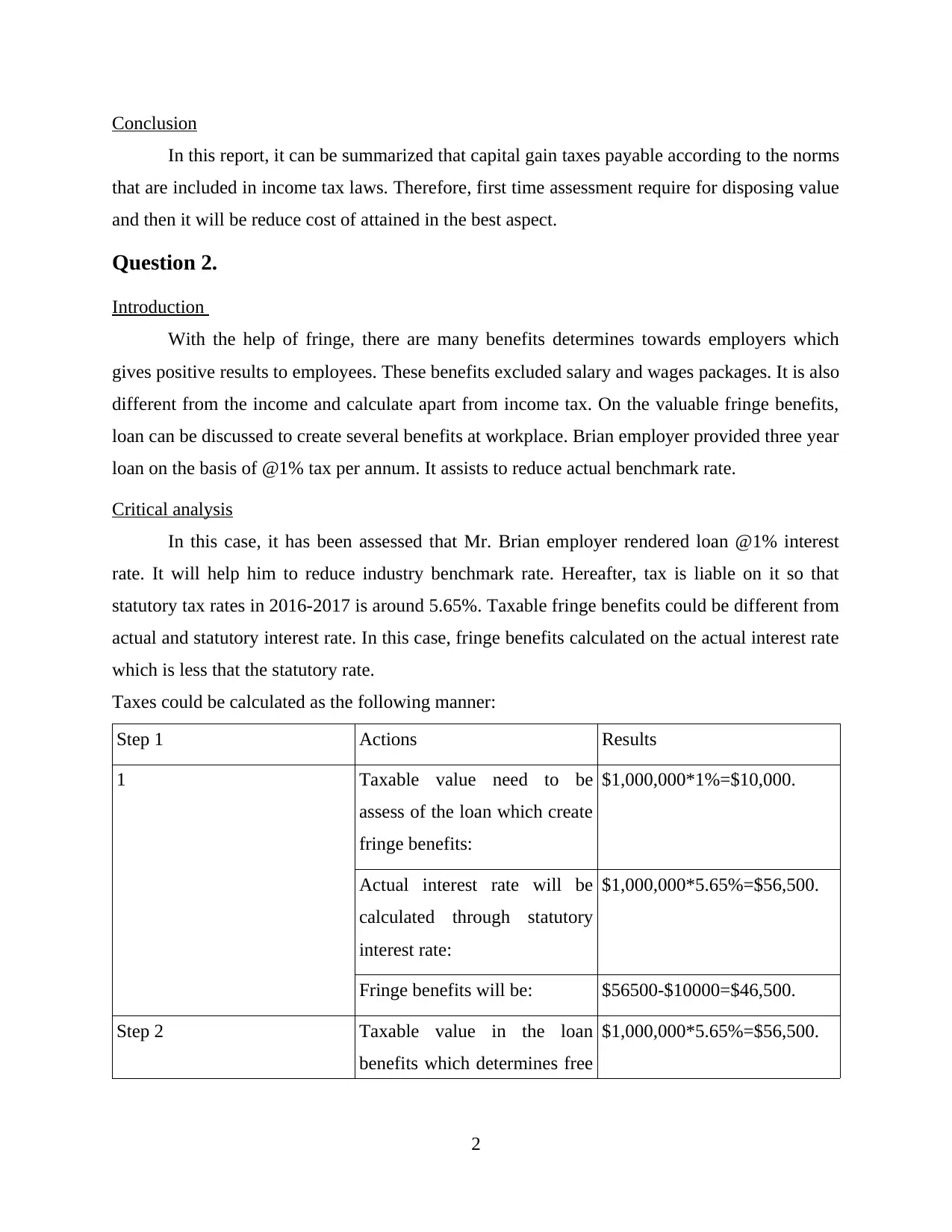
Conclusion
In this report, it can be summarized that capital gain taxes payable according to the norms
that are included in income tax laws. Therefore, first time assessment require for disposing value
and then it will be reduce cost of attained in the best aspect.
Question 2.
Introduction
With the help of fringe, there are many benefits determines towards employers which
gives positive results to employees. These benefits excluded salary and wages packages. It is also
different from the income and calculate apart from income tax. On the valuable fringe benefits,
loan can be discussed to create several benefits at workplace. Brian employer provided three year
loan on the basis of @1% tax per annum. It assists to reduce actual benchmark rate.
Critical analysis
In this case, it has been assessed that Mr. Brian employer rendered loan @1% interest
rate. It will help him to reduce industry benchmark rate. Hereafter, tax is liable on it so that
statutory tax rates in 2016-2017 is around 5.65%. Taxable fringe benefits could be different from
actual and statutory interest rate. In this case, fringe benefits calculated on the actual interest rate
which is less that the statutory rate.
Taxes could be calculated as the following manner:
Step 1 Actions Results
1 Taxable value need to be
assess of the loan which create
fringe benefits:
$1,000,000*1%=$10,000.
Actual interest rate will be
calculated through statutory
interest rate:
$1,000,000*5.65%=$56,500.
Fringe benefits will be: $56500-$10000=$46,500.
Step 2 Taxable value in the loan
benefits which determines free
$1,000,000*5.65%=$56,500.
2
In this report, it can be summarized that capital gain taxes payable according to the norms
that are included in income tax laws. Therefore, first time assessment require for disposing value
and then it will be reduce cost of attained in the best aspect.
Question 2.
Introduction
With the help of fringe, there are many benefits determines towards employers which
gives positive results to employees. These benefits excluded salary and wages packages. It is also
different from the income and calculate apart from income tax. On the valuable fringe benefits,
loan can be discussed to create several benefits at workplace. Brian employer provided three year
loan on the basis of @1% tax per annum. It assists to reduce actual benchmark rate.
Critical analysis
In this case, it has been assessed that Mr. Brian employer rendered loan @1% interest
rate. It will help him to reduce industry benchmark rate. Hereafter, tax is liable on it so that
statutory tax rates in 2016-2017 is around 5.65%. Taxable fringe benefits could be different from
actual and statutory interest rate. In this case, fringe benefits calculated on the actual interest rate
which is less that the statutory rate.
Taxes could be calculated as the following manner:
Step 1 Actions Results
1 Taxable value need to be
assess of the loan which create
fringe benefits:
$1,000,000*1%=$10,000.
Actual interest rate will be
calculated through statutory
interest rate:
$1,000,000*5.65%=$56,500.
Fringe benefits will be: $56500-$10000=$46,500.
Step 2 Taxable value in the loan
benefits which determines free
$1,000,000*5.65%=$56,500.
2
Paraphrase This Document
Need a fresh take? Get an instant paraphrase of this document with our AI Paraphraser
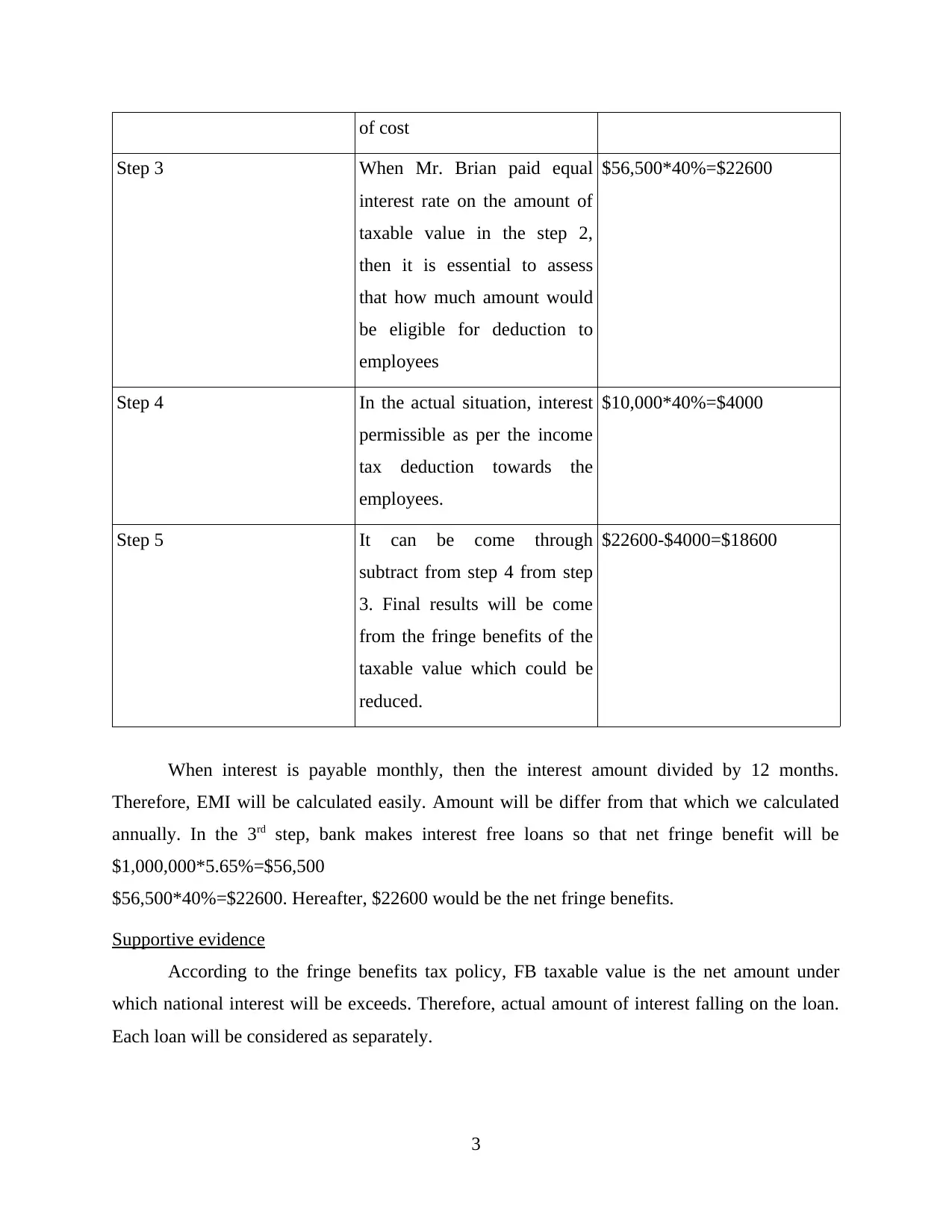
of cost
Step 3 When Mr. Brian paid equal
interest rate on the amount of
taxable value in the step 2,
then it is essential to assess
that how much amount would
be eligible for deduction to
employees
$56,500*40%=$22600
Step 4 In the actual situation, interest
permissible as per the income
tax deduction towards the
employees.
$10,000*40%=$4000
Step 5 It can be come through
subtract from step 4 from step
3. Final results will be come
from the fringe benefits of the
taxable value which could be
reduced.
$22600-$4000=$18600
When interest is payable monthly, then the interest amount divided by 12 months.
Therefore, EMI will be calculated easily. Amount will be differ from that which we calculated
annually. In the 3rd step, bank makes interest free loans so that net fringe benefit will be
$1,000,000*5.65%=$56,500
$56,500*40%=$22600. Hereafter, $22600 would be the net fringe benefits.
Supportive evidence
According to the fringe benefits tax policy, FB taxable value is the net amount under
which national interest will be exceeds. Therefore, actual amount of interest falling on the loan.
Each loan will be considered as separately.
3
Step 3 When Mr. Brian paid equal
interest rate on the amount of
taxable value in the step 2,
then it is essential to assess
that how much amount would
be eligible for deduction to
employees
$56,500*40%=$22600
Step 4 In the actual situation, interest
permissible as per the income
tax deduction towards the
employees.
$10,000*40%=$4000
Step 5 It can be come through
subtract from step 4 from step
3. Final results will be come
from the fringe benefits of the
taxable value which could be
reduced.
$22600-$4000=$18600
When interest is payable monthly, then the interest amount divided by 12 months.
Therefore, EMI will be calculated easily. Amount will be differ from that which we calculated
annually. In the 3rd step, bank makes interest free loans so that net fringe benefit will be
$1,000,000*5.65%=$56,500
$56,500*40%=$22600. Hereafter, $22600 would be the net fringe benefits.
Supportive evidence
According to the fringe benefits tax policy, FB taxable value is the net amount under
which national interest will be exceeds. Therefore, actual amount of interest falling on the loan.
Each loan will be considered as separately.
3

Conclusion
Fringe benefits are those which allotted by the employer towards employees. On the
behalf of this, employee paid tax on fringe benefit taxable amount. In addition to this, employee
need to reduce fringe benefits taxable value which is notional interest on loan. It will be
permissible as income tax deduction towards employees.
Question 3
Introduction
In this case, Jack and Jill borrowed amount for purchasing rental properly. They both
agreeing to make contract for which they agreed to share profit in ratio of 9:1. The loss is to be
bear by the Jack only. It makes for the purpose to avoid liability. In the last year, property occur
$10000 loss.
Critical analysis
In this case, people made contract to avoid tax liabilities. As results, it has been seen that
Jill housewife which is dependent lady (Verdier and Voeten, 2014). Therefore, her income
clubbed under the Jack assessment. Hence, covenant is made for lowering tax liabilities and
income which is covered by Jack. If the property incurred loss in last year, such loss will be carry
forward for the last year.
Supporting evidence
According to the tax laws of the nation, one person cannot make benefits for which they
are talk about. As results, tax is to be paid to gain capital amount which going to entitle.
Conclusion
In this give case, it can be concluded that tax is paid by Jack on capital gain for what he
earns from assets. In the last year, loss also set off form to gain capital and arise for the sale of
assets (Capital gain tax on property. 2017).
Question 4
Introduction
As per the Duke of Westminster's, it is based on the tax avoidance, they executed that
deed of conveyance is lad to servant which includes national helpers, gardeners, etc. In the
special deed, Duke decided to pay some amount for those services which he was rendering
4
Fringe benefits are those which allotted by the employer towards employees. On the
behalf of this, employee paid tax on fringe benefit taxable amount. In addition to this, employee
need to reduce fringe benefits taxable value which is notional interest on loan. It will be
permissible as income tax deduction towards employees.
Question 3
Introduction
In this case, Jack and Jill borrowed amount for purchasing rental properly. They both
agreeing to make contract for which they agreed to share profit in ratio of 9:1. The loss is to be
bear by the Jack only. It makes for the purpose to avoid liability. In the last year, property occur
$10000 loss.
Critical analysis
In this case, people made contract to avoid tax liabilities. As results, it has been seen that
Jill housewife which is dependent lady (Verdier and Voeten, 2014). Therefore, her income
clubbed under the Jack assessment. Hence, covenant is made for lowering tax liabilities and
income which is covered by Jack. If the property incurred loss in last year, such loss will be carry
forward for the last year.
Supporting evidence
According to the tax laws of the nation, one person cannot make benefits for which they
are talk about. As results, tax is to be paid to gain capital amount which going to entitle.
Conclusion
In this give case, it can be concluded that tax is paid by Jack on capital gain for what he
earns from assets. In the last year, loss also set off form to gain capital and arise for the sale of
assets (Capital gain tax on property. 2017).
Question 4
Introduction
As per the Duke of Westminster's, it is based on the tax avoidance, they executed that
deed of conveyance is lad to servant which includes national helpers, gardeners, etc. In the
special deed, Duke decided to pay some amount for those services which he was rendering
4
⊘ This is a preview!⊘
Do you want full access?
Subscribe today to unlock all pages.

Trusted by 1+ million students worldwide
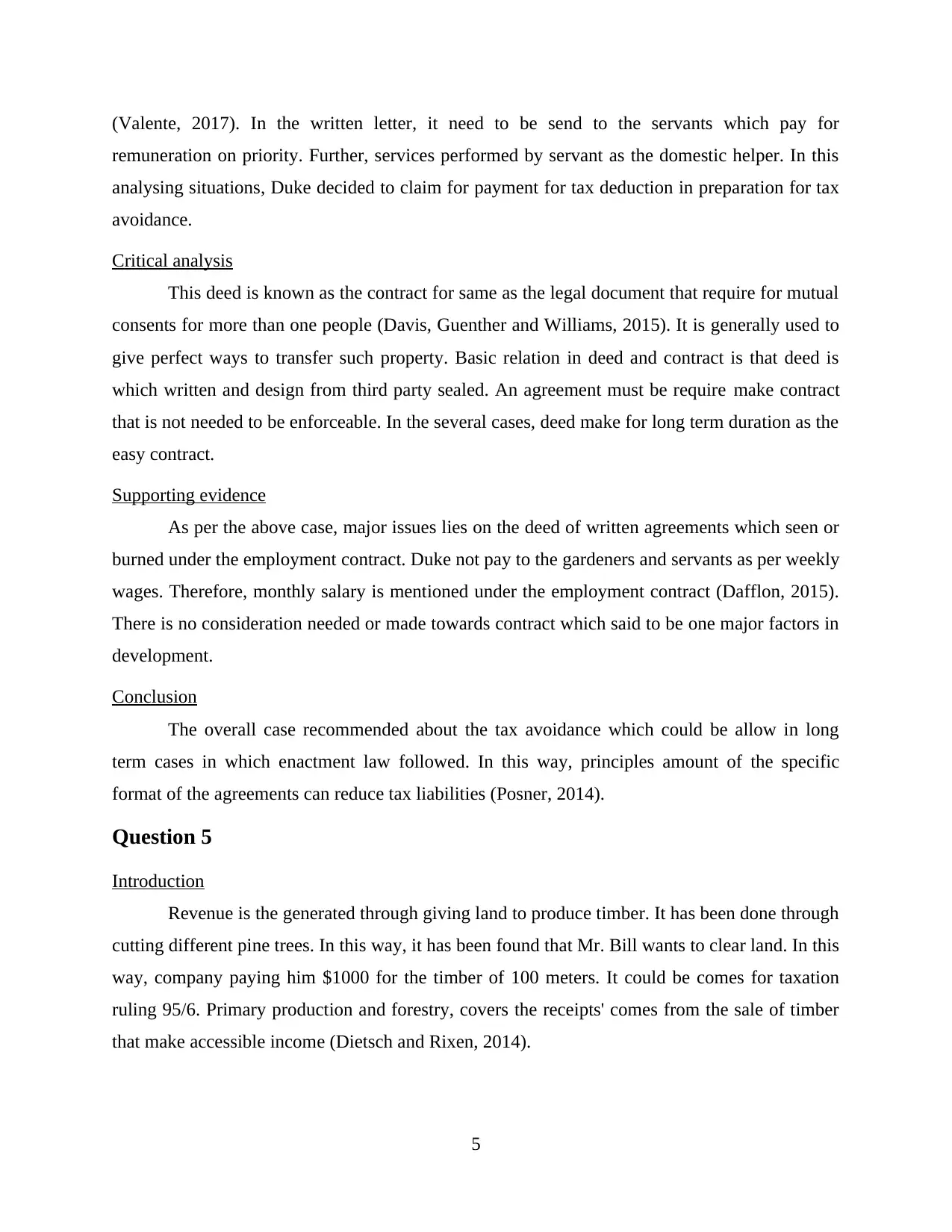
(Valente, 2017). In the written letter, it need to be send to the servants which pay for
remuneration on priority. Further, services performed by servant as the domestic helper. In this
analysing situations, Duke decided to claim for payment for tax deduction in preparation for tax
avoidance.
Critical analysis
This deed is known as the contract for same as the legal document that require for mutual
consents for more than one people (Davis, Guenther and Williams, 2015). It is generally used to
give perfect ways to transfer such property. Basic relation in deed and contract is that deed is
which written and design from third party sealed. An agreement must be require make contract
that is not needed to be enforceable. In the several cases, deed make for long term duration as the
easy contract.
Supporting evidence
As per the above case, major issues lies on the deed of written agreements which seen or
burned under the employment contract. Duke not pay to the gardeners and servants as per weekly
wages. Therefore, monthly salary is mentioned under the employment contract (Dafflon, 2015).
There is no consideration needed or made towards contract which said to be one major factors in
development.
Conclusion
The overall case recommended about the tax avoidance which could be allow in long
term cases in which enactment law followed. In this way, principles amount of the specific
format of the agreements can reduce tax liabilities (Posner, 2014).
Question 5
Introduction
Revenue is the generated through giving land to produce timber. It has been done through
cutting different pine trees. In this way, it has been found that Mr. Bill wants to clear land. In this
way, company paying him $1000 for the timber of 100 meters. It could be comes for taxation
ruling 95/6. Primary production and forestry, covers the receipts' comes from the sale of timber
that make accessible income (Dietsch and Rixen, 2014).
5
remuneration on priority. Further, services performed by servant as the domestic helper. In this
analysing situations, Duke decided to claim for payment for tax deduction in preparation for tax
avoidance.
Critical analysis
This deed is known as the contract for same as the legal document that require for mutual
consents for more than one people (Davis, Guenther and Williams, 2015). It is generally used to
give perfect ways to transfer such property. Basic relation in deed and contract is that deed is
which written and design from third party sealed. An agreement must be require make contract
that is not needed to be enforceable. In the several cases, deed make for long term duration as the
easy contract.
Supporting evidence
As per the above case, major issues lies on the deed of written agreements which seen or
burned under the employment contract. Duke not pay to the gardeners and servants as per weekly
wages. Therefore, monthly salary is mentioned under the employment contract (Dafflon, 2015).
There is no consideration needed or made towards contract which said to be one major factors in
development.
Conclusion
The overall case recommended about the tax avoidance which could be allow in long
term cases in which enactment law followed. In this way, principles amount of the specific
format of the agreements can reduce tax liabilities (Posner, 2014).
Question 5
Introduction
Revenue is the generated through giving land to produce timber. It has been done through
cutting different pine trees. In this way, it has been found that Mr. Bill wants to clear land. In this
way, company paying him $1000 for the timber of 100 meters. It could be comes for taxation
ruling 95/6. Primary production and forestry, covers the receipts' comes from the sale of timber
that make accessible income (Dietsch and Rixen, 2014).
5
Paraphrase This Document
Need a fresh take? Get an instant paraphrase of this document with our AI Paraphraser
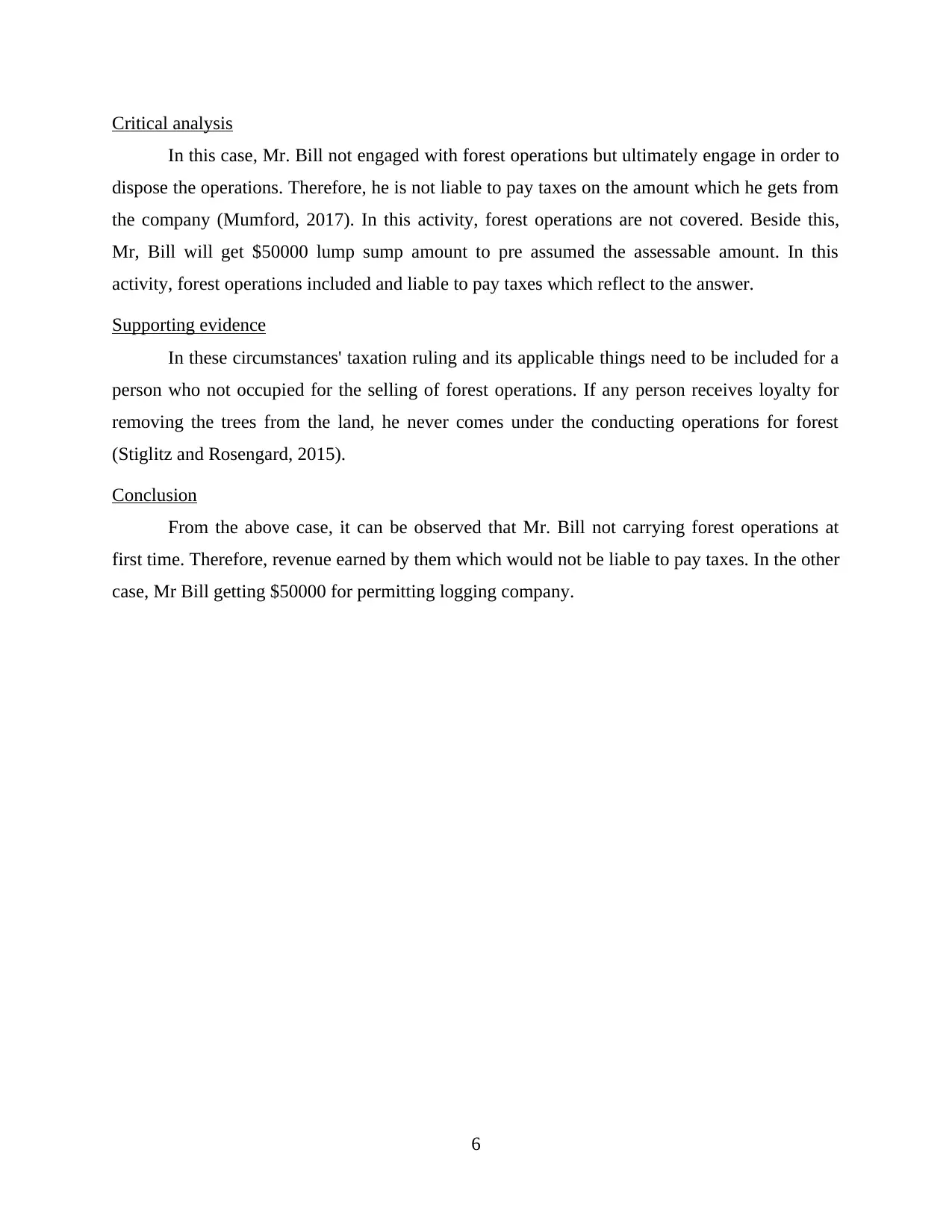
Critical analysis
In this case, Mr. Bill not engaged with forest operations but ultimately engage in order to
dispose the operations. Therefore, he is not liable to pay taxes on the amount which he gets from
the company (Mumford, 2017). In this activity, forest operations are not covered. Beside this,
Mr, Bill will get $50000 lump sump amount to pre assumed the assessable amount. In this
activity, forest operations included and liable to pay taxes which reflect to the answer.
Supporting evidence
In these circumstances' taxation ruling and its applicable things need to be included for a
person who not occupied for the selling of forest operations. If any person receives loyalty for
removing the trees from the land, he never comes under the conducting operations for forest
(Stiglitz and Rosengard, 2015).
Conclusion
From the above case, it can be observed that Mr. Bill not carrying forest operations at
first time. Therefore, revenue earned by them which would not be liable to pay taxes. In the other
case, Mr Bill getting $50000 for permitting logging company.
6
In this case, Mr. Bill not engaged with forest operations but ultimately engage in order to
dispose the operations. Therefore, he is not liable to pay taxes on the amount which he gets from
the company (Mumford, 2017). In this activity, forest operations are not covered. Beside this,
Mr, Bill will get $50000 lump sump amount to pre assumed the assessable amount. In this
activity, forest operations included and liable to pay taxes which reflect to the answer.
Supporting evidence
In these circumstances' taxation ruling and its applicable things need to be included for a
person who not occupied for the selling of forest operations. If any person receives loyalty for
removing the trees from the land, he never comes under the conducting operations for forest
(Stiglitz and Rosengard, 2015).
Conclusion
From the above case, it can be observed that Mr. Bill not carrying forest operations at
first time. Therefore, revenue earned by them which would not be liable to pay taxes. In the other
case, Mr Bill getting $50000 for permitting logging company.
6
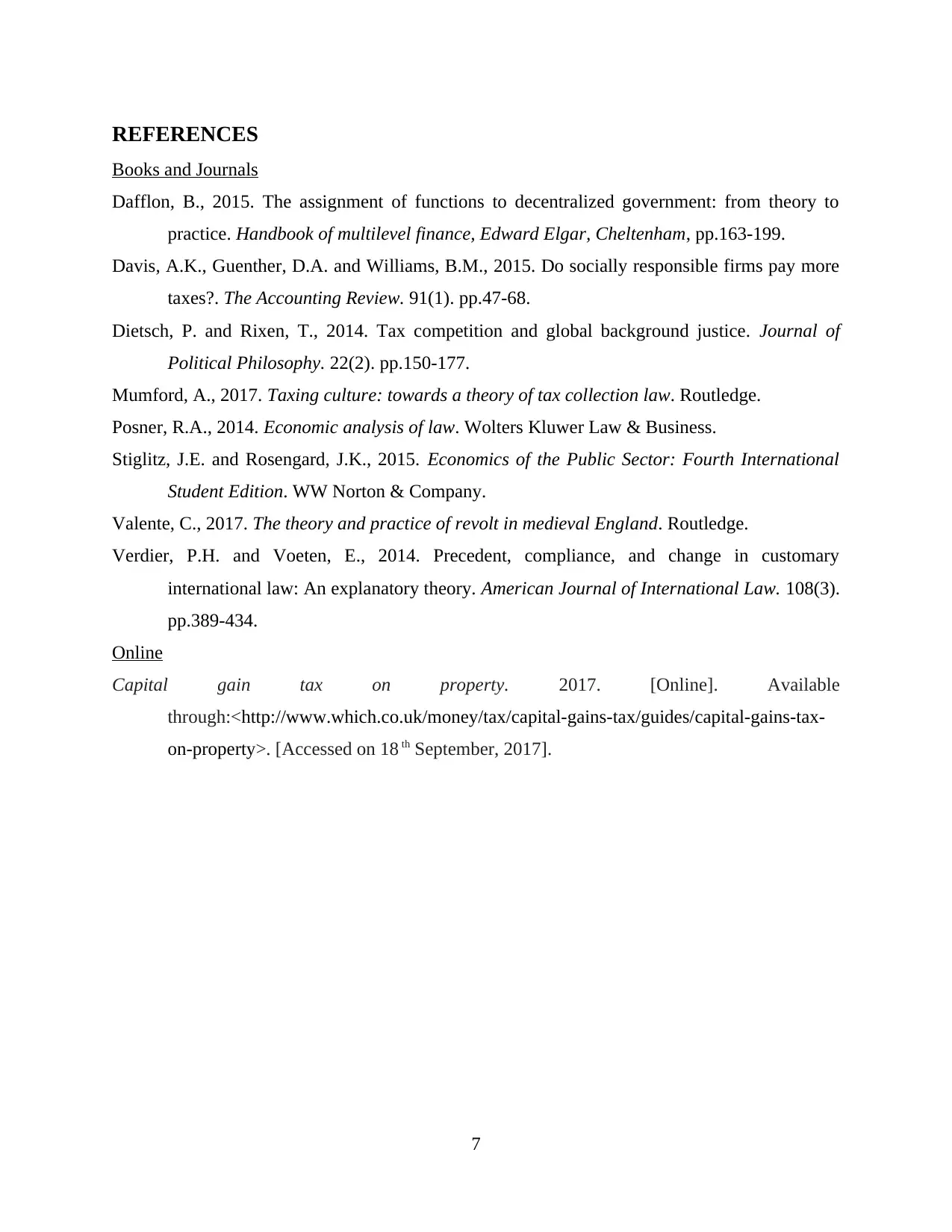
REFERENCES
Books and Journals
Dafflon, B., 2015. The assignment of functions to decentralized government: from theory to
practice. Handbook of multilevel finance, Edward Elgar, Cheltenham, pp.163-199.
Davis, A.K., Guenther, D.A. and Williams, B.M., 2015. Do socially responsible firms pay more
taxes?. The Accounting Review. 91(1). pp.47-68.
Dietsch, P. and Rixen, T., 2014. Tax competition and global background justice. Journal of
Political Philosophy. 22(2). pp.150-177.
Mumford, A., 2017. Taxing culture: towards a theory of tax collection law. Routledge.
Posner, R.A., 2014. Economic analysis of law. Wolters Kluwer Law & Business.
Stiglitz, J.E. and Rosengard, J.K., 2015. Economics of the Public Sector: Fourth International
Student Edition. WW Norton & Company.
Valente, C., 2017. The theory and practice of revolt in medieval England. Routledge.
Verdier, P.H. and Voeten, E., 2014. Precedent, compliance, and change in customary
international law: An explanatory theory. American Journal of International Law. 108(3).
pp.389-434.
Online
Capital gain tax on property. 2017. [Online]. Available
through:<http://www.which.co.uk/money/tax/capital-gains-tax/guides/capital-gains-tax-
on-property>. [Accessed on 18 th September, 2017].
7
Books and Journals
Dafflon, B., 2015. The assignment of functions to decentralized government: from theory to
practice. Handbook of multilevel finance, Edward Elgar, Cheltenham, pp.163-199.
Davis, A.K., Guenther, D.A. and Williams, B.M., 2015. Do socially responsible firms pay more
taxes?. The Accounting Review. 91(1). pp.47-68.
Dietsch, P. and Rixen, T., 2014. Tax competition and global background justice. Journal of
Political Philosophy. 22(2). pp.150-177.
Mumford, A., 2017. Taxing culture: towards a theory of tax collection law. Routledge.
Posner, R.A., 2014. Economic analysis of law. Wolters Kluwer Law & Business.
Stiglitz, J.E. and Rosengard, J.K., 2015. Economics of the Public Sector: Fourth International
Student Edition. WW Norton & Company.
Valente, C., 2017. The theory and practice of revolt in medieval England. Routledge.
Verdier, P.H. and Voeten, E., 2014. Precedent, compliance, and change in customary
international law: An explanatory theory. American Journal of International Law. 108(3).
pp.389-434.
Online
Capital gain tax on property. 2017. [Online]. Available
through:<http://www.which.co.uk/money/tax/capital-gains-tax/guides/capital-gains-tax-
on-property>. [Accessed on 18 th September, 2017].
7
⊘ This is a preview!⊘
Do you want full access?
Subscribe today to unlock all pages.

Trusted by 1+ million students worldwide
1 out of 9
Related Documents
Your All-in-One AI-Powered Toolkit for Academic Success.
+13062052269
info@desklib.com
Available 24*7 on WhatsApp / Email
![[object Object]](/_next/static/media/star-bottom.7253800d.svg)
Unlock your academic potential
Copyright © 2020–2025 A2Z Services. All Rights Reserved. Developed and managed by ZUCOL.





